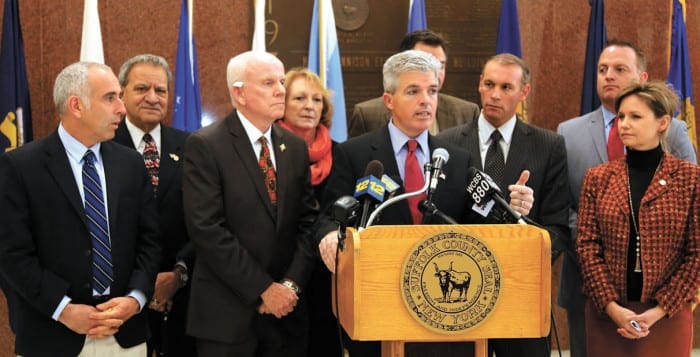
By Chris Mellides
The legislative office building in Albany hums with activity as concerned Long Island parents and members of the addiction treatment community prepare to convene with state assemblymen and insurance company executives for a roundtable discussion.
King’s Park residents Linda Ventura and Maureen Rossi, who both endured the long drive to the state capital the previous night, break away from their group moments before the meeting and casually walk to the nearest bathroom.
Inside the brightly lit lavatory, where toilet paper lines the old tiled floor, Ventura reaches into her purse and retrieves a piece of Tupperware, like she has many times before, and together with Rossi the two of them pray.
Ventura, a mother of three, watched helplessly as her eldest son Thomas succumbed to his heroin addiction two years ago. And now his ashes, tucked neatly inside that plastic container, serve as a reminder of why she tirelessly works toward spreading opiate awareness and tirelessly lobbies for political change. For such efforts Linda Ventura has been selected as one of the People of the Year by this paper.
Jeffrey Reynolds, president and chief executive officer of the Family and Children’s Association, was among those concerned parents and addiction treatment advocates who joined the dozens of insurance executives at the round table meeting.
He recalls the tension choking the room and the moment a state legislator asked Ventura to make her case for why she thinks insurance companies are handling treatment coverage poorly.
“Linda opened her purse, took out a Tupperware, put it on the table and said, ‘This is my son Thomas. This is what outpatient treatment looks like.’ And the room was stunned,” said Reynolds. “You know I’ve seen it all and done it all and heard it all, and it left me and everybody else in the room speechless.”
Reynolds says that he met Ventura roughly two years ago through a mutual contact and that his work with her became much more focused when they started their legislative push.
“She has been at the forefront of our push for a number of bills in Albany. The thing about Linda is that addiction messed with the wrong mom,” Reynolds said.
Ventura, 54, was born and raised in Oceanside and moved to Kings Park in 1993, where she’s continued her work as a financial advisor.
In March 2012, her son Thomas died from a heroin overdose. He was 21. In the years leading up to his death, Ventura says that a tumultuous family life had put stress on her children.
“My mom and dad passed and my ex-husband’s mom passed. Every year we lost one of them and him and I were going through a divorce,” Ventura said. “So there was a lot of loss, tremendous loss in the family and Thomas was especially sensitive.”
At 15 years old, Thomas began smoking marijuana and drinking beer, and by his senior year of high school Ventura recognized that her son had a problem with prescription painkillers. During the fall after his graduation, Thomas went to his first rehab.
That’s when Ventura said she realized how difficult it was to get insurance coverage for her son’s treatment.
“While he was covered under his dad’s policy, the family as a whole was entitled to one stay at a rehab. So we used that the first time that he went. It was then covered under me,” Ventura said. “We heard things through the next few years and [were told] that he’s not high enough for treatment, which still boggles my mind.”
In order to receive continued coverage for treatment services, Thomas had to continually fail at outpatient services before he could be approved for more comprehensive residential treatment, according to Ventura, who claims that this rule was “insane.”
After her son’s fatal overdose, Ventura said she knew that she needed to bring awareness to the opiate problem affecting Long Islanders, and help to change how insurance providers offer coverage to families seeking help for their sons and daughters struggling with addiction.
On the one-year anniversary of her son’s death, she launched Thomas’ Hope, a nonprofit foundation that promotes drug awareness, prevention and advocacy. Through this effort, Ventura has spoken at numerous events to raise awareness and has raised money to assist families battling with substance abuse.
During a Thomas’ Hope fundraiser Ventura met Maureen Rossi, chairperson of Kings Park in the kNOw (KPITK), a grassroots nonprofit designed to help eradicate illegal drugs from the Kings
Park Community.
“From the first time I heard Linda speak, I knew she had the gift — she has an outstanding ability to reach people,” Rossi said. “I was impressed with her work and shortly after I hired her to speak at our annual Preventing Destructive Decisions event. Linda’s actions and words move mountains.”
Together, Ventura and Rossi joined parents and community leaders in what would be several legislative visits to Albany.
Late this spring, they pushed for passage of Senate Bill S4623, which would reign in the insurance companies and force them to pay for treatment when it’s warranted. That bill and a number of others passed the state Senate and will go into effect April 1, 2015.
County Legislator Robert Trotta (R-Fort Salonga) represents Suffolk’s 13th District, has followed Ventura’s work with KPITK and has recognized the impact she’s made on the local community and on New York state as a whole.
“She went up to Albany and she got 13 different pieces of legislation passed, and the most important one is that insurance companies will be paying for treatment programs,” Trotta. “She’s driven, she’s smart, capable and she knows what’s going on. She’s really led the charge.”
Ventura said she hopes to see a sober high school brought to Long Island this year that would serve as “a place kids can come back to and be treated differently when they come out of rehab.” She also said she plans to discuss prescription protocol and the need for better education among medical professionals who prescribe controlled substances when she returns to Albany.
When it comes to stomping out the heroin and opiate epidemic on Long Island Ventura said it’ll have to be done as a group effort.
“New York and Long Island is the epicenter of the epidemic, which is something we should not be proud of,” Ventura said. “We can’t legislate ourselves out of it and we can’t police our way out of it. Those things are important measures to take, but everybody’s got to step up to the plate.”







